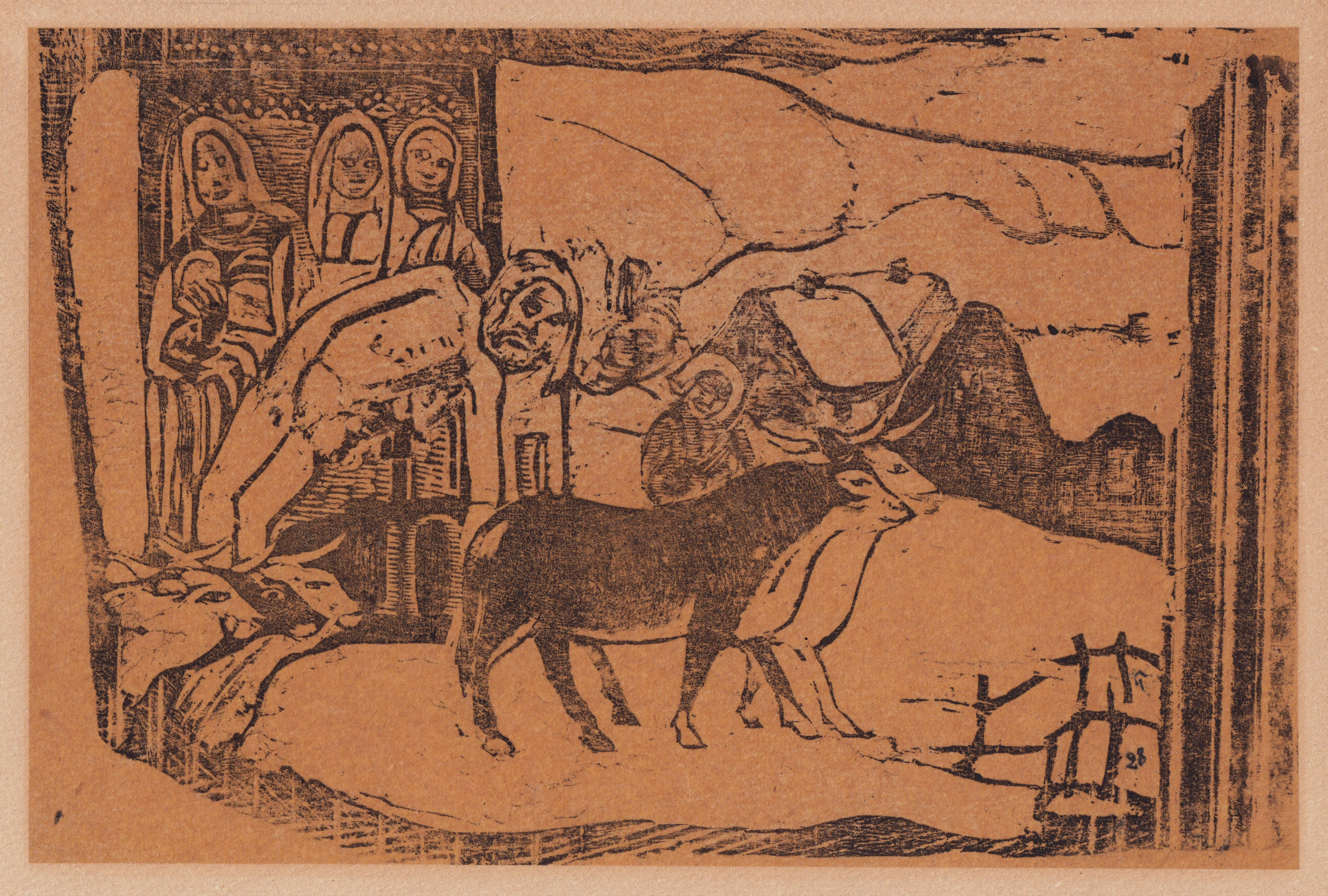
|
|
Le
Calvaire Breton
The Wayside Shrine in Brittany
Guérin 68; Mongan,
Kornfeld & Joachim 50
woodcut, 1898-89, on
tissue-thin Japon
paper, finely laid down on medium-heavy tan-beige wove paper, with a narrow
margin on the left and slightly trimmed into the subject elsewhere
(Paul Gauguin most often cut
his impressions down closely, sometimes significantly into the
composition)
signed by the artist in black ink with his initial "P" lower right, and numbered "28",
exceptionally with uniformly monotyped orange-ochre toning to the sheet by the
artist before printing of the image; the print itself is very fine
condition, with no defects visible aside from a fleck of black ink
lower left
S.
150x227mm.* (The original woodblock, now held in the Bibliothèque
Nationale de France, measures 165 × 265mm overall)

|
Provenance: formerly in the collection of the art historian,
Lawrence Saphire (not listed among the 17 impressions that Mongan,
Kornfeld & Joachim identify)
Gauguin
returned to France
from Tahiti in July 1893, spending two years, mostly
between
Paris and Brittany, with a final stay in Pont Aven during
1894. Back in Tahiti the following year, he undertook his last
printmaking project in 1898-99, mixing Tahitian and Breton themes,
often in the same series.
Le Calvaire Breton
is usually dated to
1898-9, as one of his late woodblock series, well after his return to
Tahiti, though it incorporates the Deposition of Christ from the 15th
century Calvary of Nizon, near Pont Aven**, which Gauguin painted in
the picture of the same title, Le
Calvaire Breton or Christ Vert
in 1889 (Wildenstein 328 , now in the
Musées Royaux
des Beaux Arts de Belgique, below,
left).
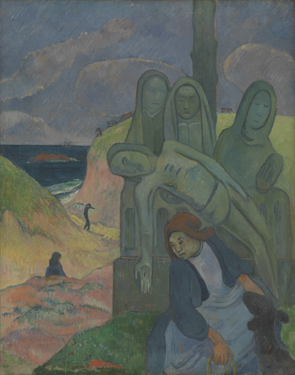
To the print,
in place of the rugged Breton dunescape in the picture, Gauguin added a hilly winter village background with a cluster of
houses and teams of oxen moving across the
front of the scene, to the right, toward
what would appear to be an enclosure.
We
know that Gauguin
intended to use this print as the leftmost panel of a
triptych of woodcuts, with the Char à Boeufs set in the middle
and Misères Humaines (below, right) to the right. (See
the cogent discussion by Richard Brettell
of this series in
the Gauguin
exhibition
catalogue, RMN, Paris 1989, pp. 417-421, as well as their theoretical
assembly reproduced in the Art Institute of Chicago study of Gauguin's
woodcuts.***)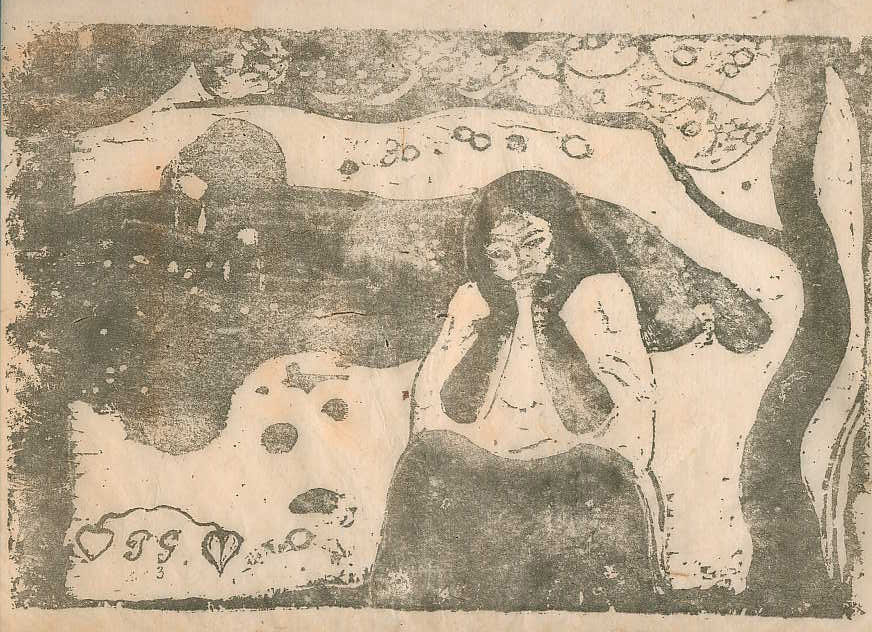
In this
context, the Calvaire is
scenographically compatible with the Char
à Boeufs,
as it has the same snow-capped houses with snow-bound hills in the
background, and the same hieratically
aligned oxen. With the palissade to the far right, abutting that of
the Char à Boeufs, it may be
seen that if each sheet
were trimmed to whatever width, they would fit well. The Art
Institute of Chicago's Technical
Study
also includes a demonstration that the two wood blocks were probably
hewn from the same plank of indigenous wood, which reinforces Gauguin's
intent.
The subject of
Gauguin's scenography however, is not just
a
wintry village scene. It relates more especially to well-known
Breton folklore: it is said that the
animals, on Christmas Eve, steadfastly keep watch (it
is said that only toads and humans
sleep!),
and they speak together in human tongue, with the uncanny ability to foresee
the future.**
Given his
mystical
interest in such traditions, both in Brittany and Tahiti, Gauguin was
most certainly aware of this belief, which
would have influenced his
work, as well as the Breton scenography here present.
It should be
added too that our impression is a good example of Gauguin's
exploration of color in his late woodcut printmaking. Gauguin began experimenting
with color in the Noa Noa series of woodcuts, and his
coloring is rather varied: most often with the application of earth
colors,
sometimes in zones or a thinned, uniform toning, elsewhere
as a watercolor wash, either applied in zones before printing the
keyplate, other times applied directly over the impression.
These
various techniques have been studied in
depth by a curatorial team
from the the Art
Institute of Chicago.**** 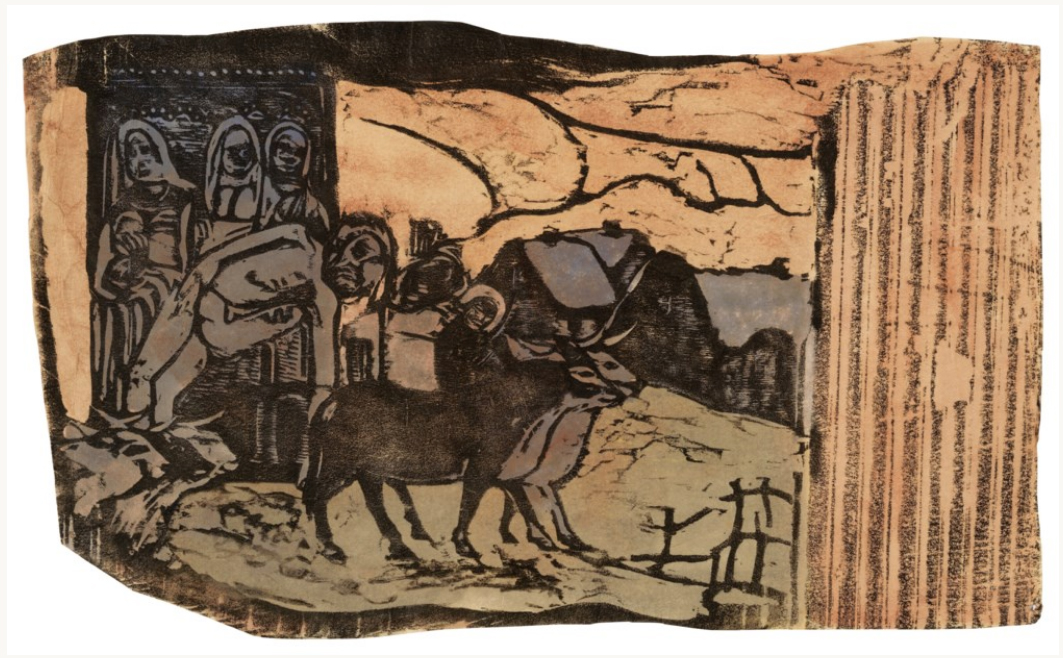
Our
impression is marked by a flat color
field of ochre, which the AIC call
"transfer coloring": in this technique the artist spreads a film of ink
over a flat matrix which is then impressed onto the blank sheet.
We know of one other impression of Gaugin's Calvaire Breton with additional hand coloring from the Kelton Collection (right), which is chromatically
comparable to ours in the background color field, and which Gauguin
ostensibly intended to connote the culminating events of the Passion:
the Deposition from the Cross and the Lamentation of Christ by the
three Marys. Several of the Evangelists relate that, during the
Crucifixion, darkness spread across the land and the sun stopped shining, and this may well have inspired Gauguin's represention of the scene here.
Gauguin's
concern with religious themes in any case ran through a good part of
his life, and was summed up in the unpublished work, L'Esprit Moderne et le Catholicisme
(now in the Saint Louis Art Museum, see
https://www.slam.org/collection/objects/18302/?ocaid=modern-thought-and-catholicism-gauguin#mode/2up)
a synthetist approach to the religions of the world that he completed
in the Marquesas in 1902, and which here is evident in the cortege of
oxen, moving from Calvary to the Nativity.
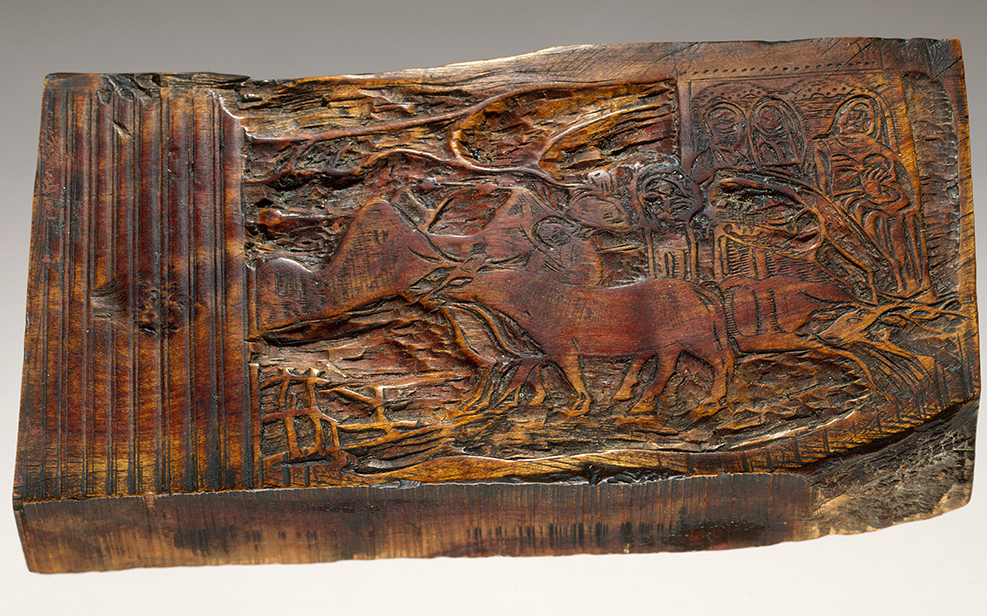
* Mongan,
Kornfeld & Joachim
give the dimensions of the early impressions as 161 x250 mm,
again most ofen cut down, in variable formats.
Cf. the Art institute of Chicago
impression, from the renowned Marcel Guérin collection, at
https://www.artic.edu/artworks/60634/wayside-shrine-in-brittany-from-the-suite-of-late-wood-block-prints,
where the dimensions of the
trimmed sheet are given as 152 × 227 mm; in comparison, our
impression is cropped slightly along the top border.
Cf. also the impression sold at Sotheby's
(https://www.sothebys.com/en/buy/auction/2022/prints-multiples/le-calvaire-breton-g-68-k-50),
which is cropped more markedly into the left edge of the composition and along the bottom
**
https://monumentum.fr/monument-historique/pa00090287/pont-aven-calvaire
***
See https://publications.artic.edu/gauguin/reader/141096/section/140419,
and especially the analysis by Harriet Stratis:
"Gauguin took
the thick, irregular pieces of wood he found in Tahiti, including more
rectilinear planks, and crudely cut them down laterally to reduce their
thickness. Taking into consideration that the indigenous wood was not
commercially
manufactured into regularly sized blocks, the unusual,
irregular contours and grain in the wood used by Gauguin provide
topographical reference points that allow them to be matched and
paired. Five such pairs were identified during the course of this
study. These include Wayside Shrine in
Brittany and The Ox
Cart"
(See in particular: https://publications.artic.edu/gauguin/reader/141096/section/140412/p-140412-17)
**** See
François-Marie Luzel, Légendes
Chrétiennes de la Basse Bretagne, Paris 1881, pp. 329 et seq. In one of the legends, on
Christmas Eve, a large red ox spoke thus:
- Our Lord is born, my
children, the merciful and almighty God, and he was not born in a
palace or in the house of a rich man of the earth;
he came into the world, like the
last of the unfortunate, in a manger, between an ox and a donkey! Glory
to the Lord!
- See also:
https://fr.wikisource.org/wiki/L%C3%A9gendes_chr%C3%A9tiennes_de_la_Basse-Bretagne/Veill%C3%A9e_bretonne
and
-
http://www.tresor-breton.bzh/2019/12/29/les-animaux-se-parlent-en-breton-la-nuit-de-noel/
***** See Daher, Sutherland, Stratis, & Casadio, Paul Gauguin's Noa Noa prints:
Multi-analytical characterization of the printmaking techniques and
materials, in Microchemical
Journal, 2018, 138, pp.348-359.
There is also a
video demonstration of these printing
techniques that the Art Intitute of Chicago has produced, now visible
online here: https://www.youtube.com/watch?v=eoVT2UZ_drs

